As we blogged about previously, gongfu brewing is not about possession of ethereal skills that are honed over decades, rather it is about effort and time.
There are 3 main schools of gongfu brewing, namely Chaozhou, Fujian and Taiwanese styles respectively.
As it is widely believed that gongfu brewing originated from Chaozhou in Guangzhou, we will compare the different schools with a reference to the Chaozhou style of brewing.
While specific execution does differ among practitioners, the key difference is in the equipment but let us start from the granddaddy of them- Chaozhou brewing.
Chaozhou Gongfu Brewing
The tea chosen is a Tieguanyin, a tea that binds all 3 schools, originating in Fujian, beloved by the Chaozhou people and later being grown and produced in Taiwan as well.
Usually for Chaozhou gongfu brewing, there is an additional step of arranging the tea leaves on a piece of paper. The smaller leaves will be placed in the middle and then placed into the pot. This is done to ensure the smaller
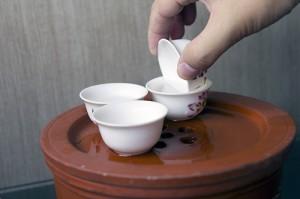
One process unique to Chaozhou gongfu brewing is the ‘rolling’ of the cup. Chaozhou gongfu brewing originated with oolong tea in mind and one of the key elements of making oolong tea is heat. The rolling of the cup is to heat it and also sterilize it.
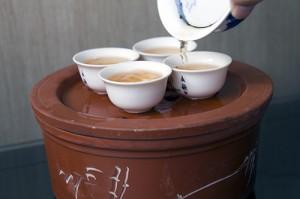
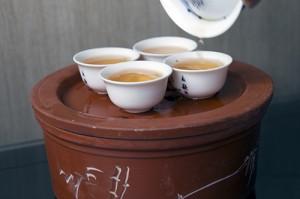
Subsequently, the last few drops remaining in the gaiwan are also distributed equally since these are considered the essence of the tea.
Fujian Gongfu Brewing
The Fujian style adds one key piece of equipment- the chahai- while subtracting the arrangement of tea leaves and the rolling of the cups.
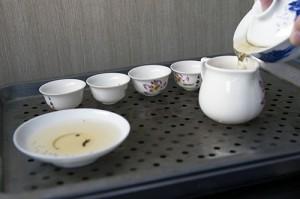
Taiwanese Gongfu Brewing
Just across the straits, the Taiwanese added a new piece of equipment- the aroma cup. These are the narrow, tall cups that are placed besides the ‘normal’ drinking cup. From the chahai, the liquor is poured into the aroma cups.
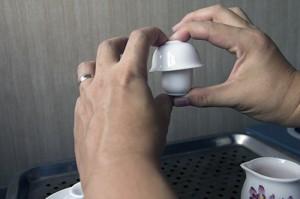
The drinker can smell the cup when it’s hot, then cool it down by rubbing the aroma cup with his or her palms and smell it again.
There are literally hundreds of fragrance compounds in tea, some are accentuated by heat. When the cup cools, you may be able to detect fragrances that were previously obscured by other fragrances.
Personal Thoughts
There are advocates for each school of brewing and I can see the merit in them.
As a matter of preference, I hardly ever do the Taiwanese way, unless it’s a demonstration or workshop.
Firstly, I am a minimalist when it comes to equipment. If it does not add value to my experience, I am usually wont to bring out additional equipment to wash use. The cup aroma can also be fully experienced by smelling an empty cup that has just been consumed, provided it is sufficiently hot.
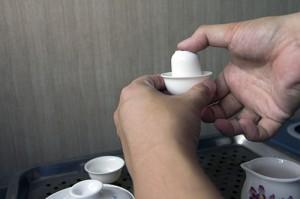
That being the case, the opposite end of the spectrum- namely Chaozhou gongfu brewing makes the most sense. No chahai, no fragrance cup, most of the heat and aroma is preserved.
However despite my personal preference, most of the time I brew the Fujian style as usually I brew for either myself or at most one guest. Pouring out into 4 cups while I consume one at a time does not retain heat as well as leaving it in a chahai where I can decant after consuming each cup.
In addition, when I am doing demonstrations or tea tastings, pouring into a chahai would keep out the debris from the tea leaves which can appear a bit unsightly.
See here for more articles related to tea appreciation.
